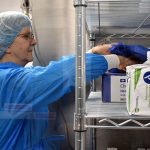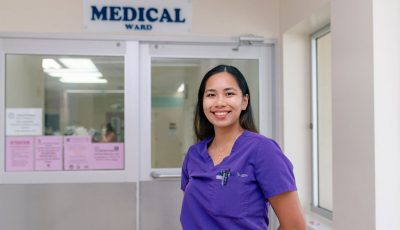CHC shows off new inpatient pharmacy
Commonwealth Healthcare Corp. officials gave a selected few a tour of the hospital’s newly renovated inpatient pharmacy. The project costs $300,000 with $200,000 coming from an appropriation from Saipan Local Law 20-19 with CHCC shouldering the rest.
CHCC chief executive officer Esther L. Muña, Public Health Emergency Preparedness Program/Hospital and Public Health Preparedness Program director Warren F. Villagomez, pharmacy manager Rodylyn Bacani, RPh, and pharmacy staff Kim Runge explained the importance of the inpatient pharmacy.
Muña said the technology used in the project is based on the guidelines and requirements set by the U.S. Pharmacopeia 797 for compounding sterile preparations. “This is much bigger. We made sure the expansion is in compliance with USP 797. So, we have to meet those standards.”
She added that they also made sure the pharmacy staff was trained to properly use the equipment in the facility. “The staff is trained including how to properly clean the facility.
The Commonwealth Health Center’s pharmacy department has 15 staff headed by Bacani with Runge, Daisy Buduan, and Jonathan Muña as the other pharmacists. The department will have two more staff, a pharmacist who recently just passed the licensure examination and one recent graduate that is currently reviewing for the exam.
Muña said the facility would ensure that medication is properly disbursed to Commonwealth Health Center patients. “The new standards are in place to ensure that the staff are safe and the medication for the patients are done safely. That is what’s important for us.
The new facility has a room where chemotherapy medicines are mixed that has a
Biological safety cabinet and another electrolytes are added in some intravenous bags for special case patients like pre-mature babies.
“Whatever the patient medication needs, this is where we are going to mix it. Our staff also needs to be protected at all times when they prepare chemo medicines since they are going to handle some toxic materials,” said Bacani.
Runge added the facility is sterile with an exhaust and ventilation system in place to properly discharge any toxic fumes. “The non-hazardous and hazardous rooms are different in a crucial way. The pressure in the non-hazardous room is higher from the other rooms to keep bacteria and viruses from flowing in.”
“In the chemo hazardous room, the pressure is lower than the surrounding rooms, and that keeps any hazardous material from wafting out. It goes out on a vent system in a safe manner so that people are not exposed.”
Villagomez added that they had to extend the vent system another 10 feet to ensure everyone’s safety. “We actually had to extend another 10 feet from the standard EPA requirement because of the proximity at the entrance to the hospital.”
“These are things that are very complicated to build—air exchange and air purity, and air humidity, and air sterilization. There’s a lot of complex work done in this area for safety, and to be able to process and mix medicines.
- Commonwealth Healthcare Corp. Esther L. Muna, center, poses with Public Health Emergency Preparedness Program/Hospital and Public Health Preparedness Program director Warren F. Villagomez, from left, Rep. Edmund Villagomez (Ind-Saipan), pharmacist Kim Runge, and pharmacy manager Rodylyn Bacani, RPh. (Jon Perez)
- Commonwealth Health Center pharmacist Kim Runge prepares materials to be used in mixing medication that a hospital patient needs. (Jon Perez)
- Commonwealth Healthcare Corp. pharmacy manager Rodylyn Bacani, RPh, right, is joined by her staff as they showcase the new inpatient pharmacy facility yesterday at the Commonwealth Health Center. (Jon Perez)






























